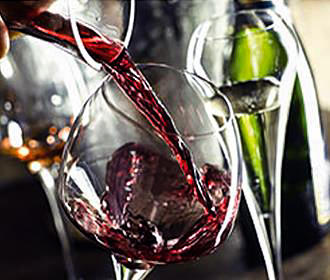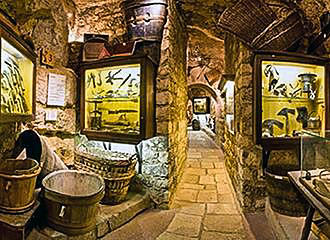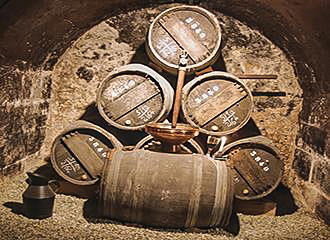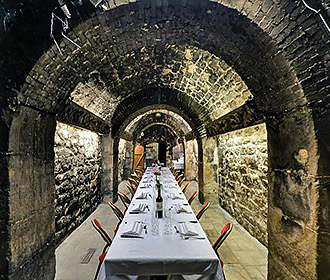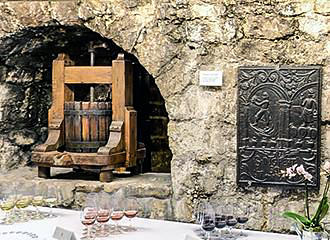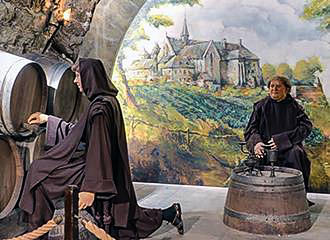The Paris Musee du Vin History
Now the Musee du Vin history first started when it was established in 1984 and is still running today under the watchful eye of the Conseil des Echansons de France, yet it is the historical venue with its centuries old cellars and the collections that make up the history of this Paris wine museum go much further back.
The Geological Location history
Originally back when the area was called Lutece before it was known as the city of Paris, there was limestone around the area and then limestone quarries were mined between the 13th and 18th century, which provided the dressed stone to build new residences for the up and coming city of Paris.
This limestone was a characteristic feature of this geological age in the history of Paris, and situated approximately 37m above sea level, the limestone was originally formed many millions of years ago by the accumulation of seashells at the bottom of the warm sea. Incredibly, you can still get to see some of the old fossils in some places around Paris today.
The tunnels were dug out of the lower part of this geological layer utilising a turning pillar technique, and this is where you will find the galleries of the Musee du Vin.
There are also pillars evenly spaced in order to support the quarry roof and stone walls were also built in order to reinforce these galleries, which were mainly put in place during the 19th century.
Also, several mineral springs waters were found in the Passy area of Paris during the 17th century and at the entrance to the Musee du Vin, or Paris wine museum, there is evidence of the existence of occasionally emerging ground water at the location. Also, you will notice that the address of the wine museum is Rue des Eaux, which translates to Road of Waters or Waters Road.
The wine cellars of a Monastery
A monastery was built by the Mendicant Friars towards the end of the 1400s and it was surrounded by gardens and terraces that went down to the River Seine, which had orchards and vines on the hillside.
The Friars from the Minimes monastery who cultivated these vines produced a light red wine that King Louis XIII used to like upon his return from hunting trips in the Bois de Boulogne, and this is why you will see street names today such as Rue des Vignes, which translates to Vinyard Road.
During the 16th and 17th centuries, the Friars of this Minimes Monastery utilised three vaulted cellars in order to store their wine, which is where you will find the Musee du Vin restaurant, called Les Echansons.
More recent times and the start of the Musee du Vin
Then in the 1950s these ancient wine cellars were re-renovated and for a period of time they were used to house the wine for the restaurant at the Eiffel Tower, which is the world famous Paris landmark that is located very close by.
However, after a short period of time, these wine cellars were no longer required by the Eiffel Tower restaurant and the wine cellars then became a wine museum, for anyone wishing to learn more about the historical practices of wine making and the history of the monastery.
The Conseil des Echansons de France
This brotherhood or council, called the Conseil des Echansons de France, was founded back in 1954 in order to promote the best of French wines and the name was chosen because it relates to the ancient tradition of the Echanson, or cup bearer, who would pour the beverage.
The person known as the Grand Echanson de France was highly regarded in society and it was deemed to be one of the greatest honours, as the Grand Echanson de France would personally serve the king at annual celebrations and would also manage the king’s wine cellars.
Today, there are over a thousand members of the Conseil or brotherhood, which includes professionals and amateurs from all over the globe, with the same dedication to the promotion of the great French wines.
In fact, the Musee du Vin was taken over by the Conseil des Echansons de France in 1984, who still own this Paris wine museum today, which means that we can also learn about wine tasting and serving along with carrying on the tradition of French heritage and the history of wines in France and Paris.
But it is also a mission to preserve the quality that accounts for the world renown of French wines, with a motto of Bonum Vinum Laetifcat Cor Hominum, which translates to Good Wine Gladdens a Persons Heart.
Therefore, at the Musee du Vin there are numerous different options for wine tasting events, workshops and courses, plus it is now a recognised training venue for those that wish to have a career in the wine industry, such as becoming a sommelier.
However, for those of you who enjoy wine, but are a complete novice, you can still get to appreciate the history of wine and wine making, the historical location and well over 2,000 different objects on display, some of which are also centuries old and have been donated by other Paris museums to make an even more complete picture.
